From Previous post: Cincinnati’s urban neighborhoods are at a tipping point. The city has lost 40% of its population since 1950 leaving suburban densities in the city’s formerly urban neighborhoods. Many residential buildings and lots sit vacant or unmaintained, with over 10,000 historically contributing units in need of renovation. Neighborhood main streets have withered due to lack of people, competition from nearby big box stores, and bad thoroughfare design that speeds cars and potential customers through these neighborhoods rather than to them. In addition, jobs followed the people to the suburbs. Read more from Part 1 here.
As part of a charrette held the week of Saturday April 28, Opticos Design built upon months of field documentation, including many hours spent on Google Earth, mapping analysis, photography, and an assessment of the existing zoning code to refine an initial calibration of Cincinnati’s Urban-to-Rural Transect.
Choosing and refining a form-based organizing principle for a city the size of Cincinnati with such a diverse range of pre-1940s urban patterns and a rich urban morphology is one of the most challenging but under-appreciated aspects of creating a Form-Based Code (FBC). For Cincinnati, the Rural-to-Urban Transect was selected as the organizing principle. The calibration of the transect allowed the team to create a framework that would reinforce the fine-grain fabric and rich palette of building types, both Missing Middle and others, that are an important part of defining the community character of the city’s urban neighborhoods.
Cincinnati’s Initial Transect Zone Calibration:
T3 Estate (T3E)
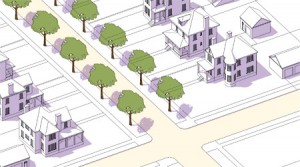
The intent of this zone is to protect the integrity of existing, large lot, detached homes and reinforce their role within walkable neighborhoods and to allow new neighborhoods with this component.
T3 Neighborhood (T3N)

The intent of this zone is to protect the integrity of existing, small- to medium-lot detached homes and reinforce their role within walkable neighborhoods and to allow new neighborhoods with this component.
T4 Neighborhood Medium Footprint (T4N.1)
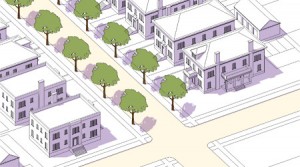
The intent of this zone is to provide a variety of housing choices, in small- to medium-footprint, medium-density building types, which reinforce the walkable nature of the neighborhood, support neighborhood-serving commercial adjacent to this zone, and support public transportation alternatives. Sub Zone: T4N.1-Open regulates for the same form as T4N.1 but allows office and service-related uses in the primary buildings. This is used typically in areas that already have zoned existing single-family areas with commercial zoning, but ensure a more compatible form in newly constructed buildings.
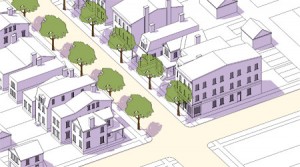
T4 Neighborhood Small Footprint (T4N.2)
The intent of this zone is to provide variety of urban housing choices, in small footprint, medium- to high-density building types, which reinforce the walkable nature of the neighborhood, support neighborhood-serving retail and service uses adjacent to this zone, and support public transportation alternatives.
T5 Main Street (T5MS)

The intent of this zone is to provide a flexible area that can accommodate a broad range of neighborhood serving retail, service, and residential uses in a medium- to high-density main street form. Sub Zone: T5MS-Open regulates for the same form as T5MS but allows a wider range of uses including residential on the ground floors. This is used typically used in areas just outside of the primary nodes in neighborhood or downtown main streets and areas transitioning from main streets into neighborhoods.
T5 Neighborhood (T5N)
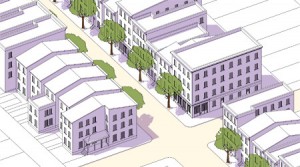
The intent of this zone is to provide a walkable urban neighborhood that integrates a diverse range of residential uses in a compact urban form within walking distance to retail and service areas. Sub Zone: T5N-Open regulates for the same primary form as T5N but allows a wider range of uses including services and general retail with shopfront frontages on the ground floors. This zone responds to the existing patterns in urban neighborhoods such as Over-the-Rhine in Cincinnati that has allows the urban form to respond to the market for commercial services within neighborhoods.
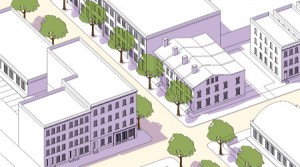
T5 Flex (T5Flex)
The intent of this zone is to provide an urban form that can accommodate a very diverse range of uses, including some light industrial, to reinforce the pattern of existing walkable neighborhoods and to encourage revitalization and investment. This zone responds directly to neighborhoods such as Camp Washington in Cincinnati that have historically had this broad range of urban forms and uses but have been zoned industrial, thus compromising the diverse mix, in particular the neighborhood component.
T6 Core (T6C)
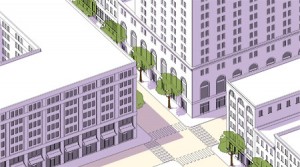
The intent of this zone is to reinforce and enhance the vibrant, walkable urban, downtown and city core and to enable it to evolve into a complete neighborhood that provides locally and regionally serving service, retail, entertainment, civic, and public uses, as well as a variety of urban housing choices. It can also be applied in the future along transit routes such as the proposed streetcar.
The first step in talking with any person or group at the charrette was walking them through this hierarchy of places that exists within Cincinnati and explaining how that was going to be the framework for the FBC. Everyone understood this approach because it makes sense. The stormwater folks started talking about BMS along the Transect, the residents found the place that best represented the neighborhoods they lived in, developers were even talking Transect zones by the end of an hour-long meeting.
A public review draft of the Cincinnati FBC is due out this fall followed by a series of neighborhood charrettes intended to be the pilot application for the Form-Based Code.
A Few Citywide Form-Based Code Tips:
Keeping the six base zones: It is important, even at the scale of larger cities or regions, to stick with the size base Transect zones as a starting point for the calibration and then to tier sub-zones off of the these six base zones.
Utilizing open sub-zones: The beauty of an FBC is if you want to regulate the same form, but allow a slightly broader range of uses for an area, you can simply create an open sub zone, such as T5 Main Street-Open, instead of creating yet another zone. This enables the code to minimize the number of zones, thus making the code easier to use.
The naming convention: We take a slightly different approach to naming our Transect zones based on our citywide zoning code experience. We break down the six primary zones, either starting at T5 and sometimes at T4, into Main Street and Neighborhood classifications. Zone names always start with the T number, then have a name related to intended primary form (usually neighborhood or main street for our calibrations), then a .1 or .2 (T4 Neighborhood 1 becomes T4N.1) if there is more than one of each zone, and a dash is introduced with an O (T5MS-O for T5 Main Street Open) for zones with a broader range of allowed uses.
Building footprint size matters: Cincinnati patterns are primarily small buildings, even in T5. This pattern is reinforced in form-based zones and will be further reinforced in the FBC.
Transect zones do not apply to all areas: Form-Based Codes are intended to regulate walkable urban areas or areas intended to transform into walkable urban areas. The drivable suburban area can retain their conventional use-based framework with some simple cleanup to help with administration. Cincinnati is fortunate to have a large percentage of their city built prior to the 1940s making much of the city walkable and a good candidate for FBC application.
– Dan
Like this article? How about these: